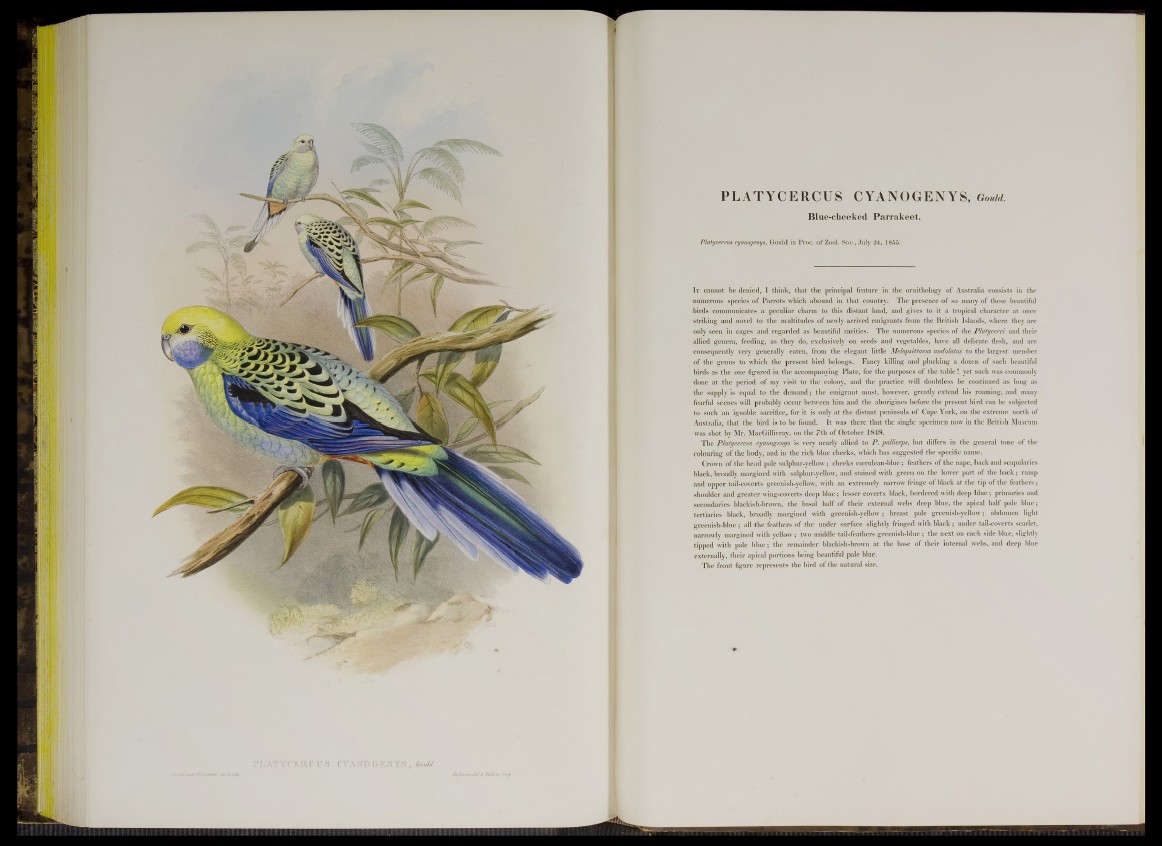
PLATYCERCUS CYANOGENYS, Gould.
Blue-cheeked Parrakeet.
Platycercus cyanogenys, Gould in Proc. of Zool. Soc., July 24, 1855.
It cannot be denied, I think, that the principal feature in the ornithology of Australia consists in the
numerous species of Parrots which abound in that country. The presence of so many of these beautiful
birds communicates a peculiar charm to this distant land, and gives to it a tropical character at once
striking and novel to the multitudes of newly arrived emigrants from the British Islands, where they are
only seen in cages and regarded as beautiful rarities. The numerous species of the Platycerci and their
allied genera, feeding, as they do, exclusively on seeds and vegetables, have all delicate flesh, and are
consequently very generally eaten, from the elegant little Melopsittacus undulatus to the largest member
of the genus to which the present bird belongs. Fancy killing and plucking a dozen of such beautiful
birds as the one figured in the accompanying Plate, for the purposes of the table! yet such was commonly
done at the period of my visit to the colony, and the practice will doubtless be continued as long as
the supply is equal to the demand; the emigrant must, however, greatly extend his roaming, and many
fearful scenes will probably occur between him and the aborigines before the present bird can be subjected
to such an ignoble sacrifice, for it is only at the distant peninsula of Cape York, on the extreme north of
Australia, that the bird is to be found. It was there that the single specimen now in the British Museum
was shot by Mr. MacGillivray, on the 7th of October 1848.
The Platycercus cyanogenys is very nearly allied to P . patticeps, but differs in the general tone of the
colouring of the body, and in the rich blue cheeks, which has suggested the specific name.
Crown of the head pale sulphur-yellow; cheeks ccerulean-blue; feathers of the nape, back and scapularies
black, broadly margined with sulphur-yellow, and stained with green on the lower part of the back; rump
and upper tail-coverts greenish-yellow, with an extremely narrow fringe of black at the tip of the feathers;
shoulder and greater wing-coverts deep blue; lesser coverts black, bordered with deep blue; primaries and
secondaries blackish-brown, the basal half of their external webs deep blue, the apical half pale blue;
tertiaries black, broadly margined with greenish-yellow; breast pale greenish-yellow; abdomen light
greenish-blue ; all the feathers of the under surface slightly fringed with black ; under tail-coverts scarlet,
narrowly margined with yellow ; two middle tail-feathers greenish-blue ; the next on each side blue, slightly
tipped with pale b lu e; the remainder blackish-brown at the base of their internal webs, and deep blue
externally, their apical portions being beautiful pale blue.
The front figure represents the bird of the natural size.